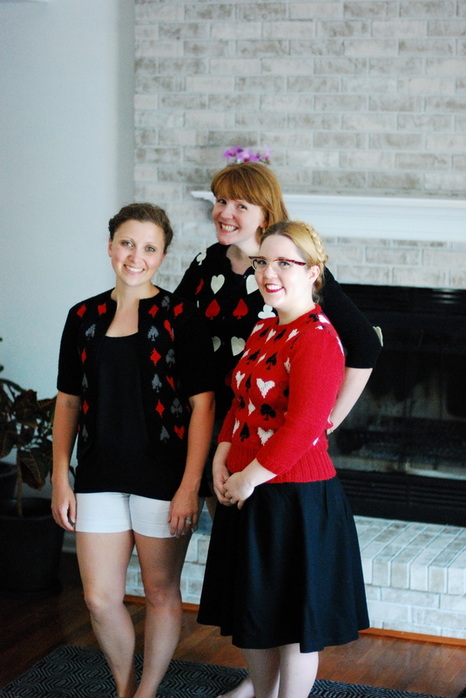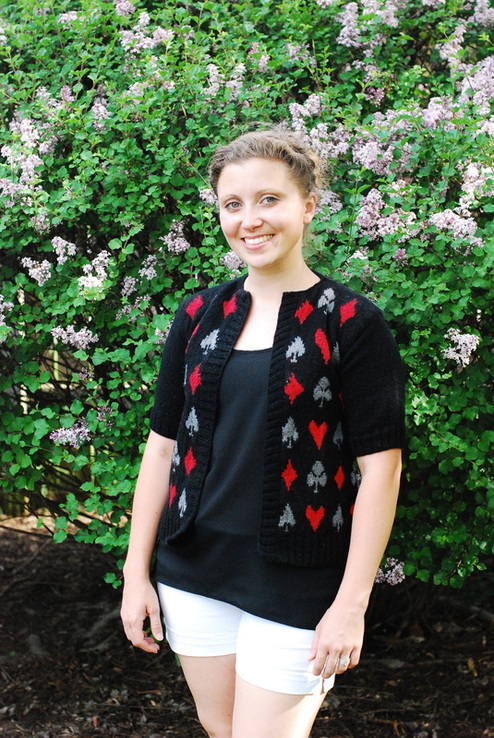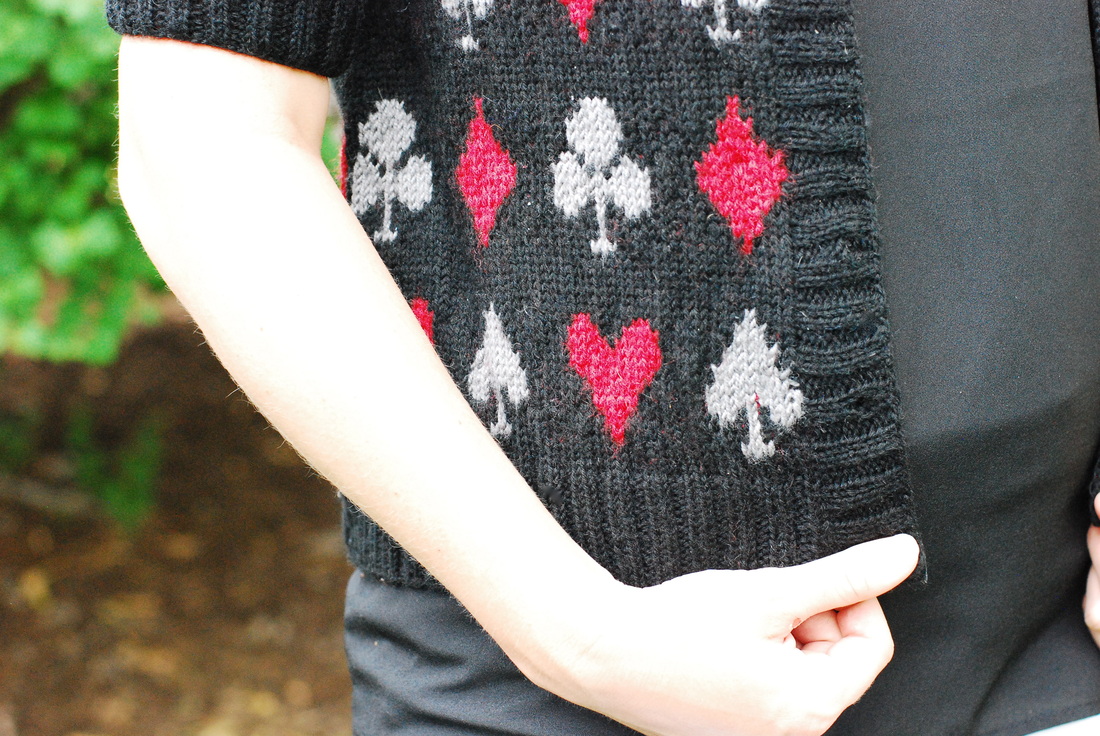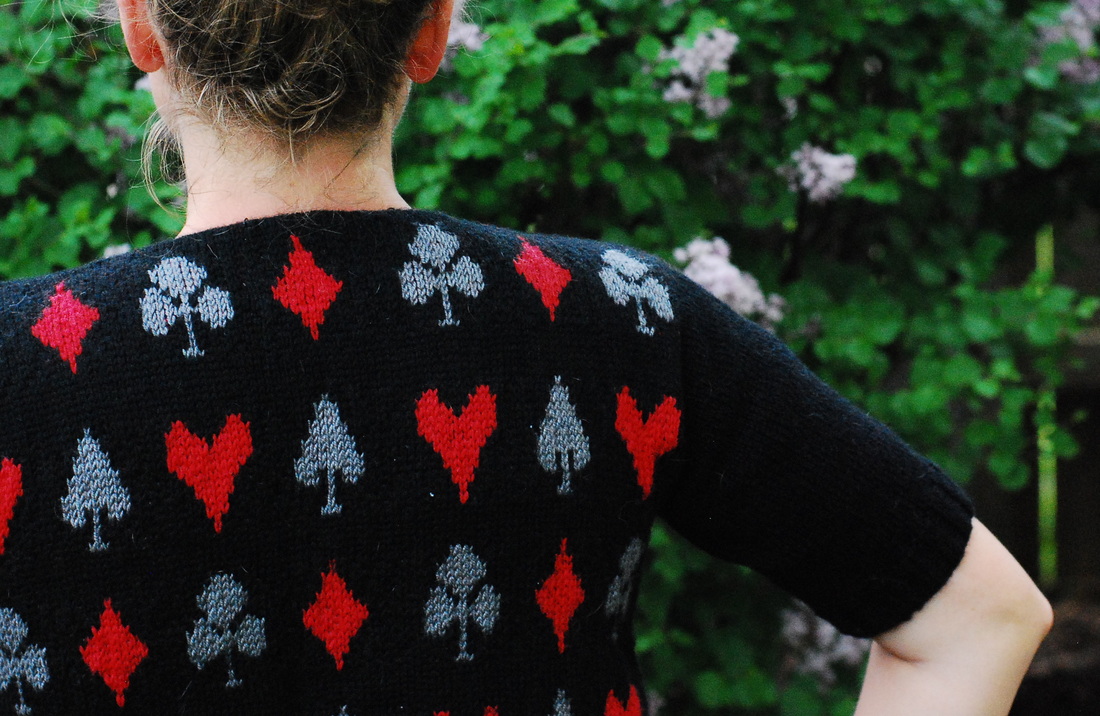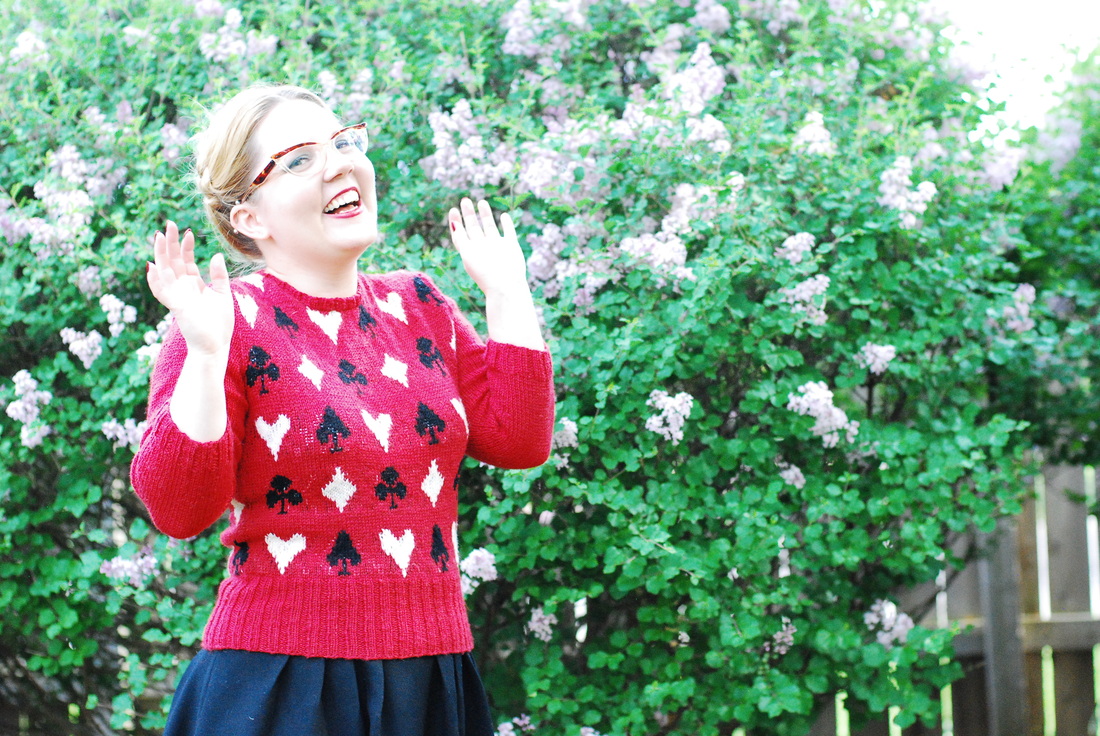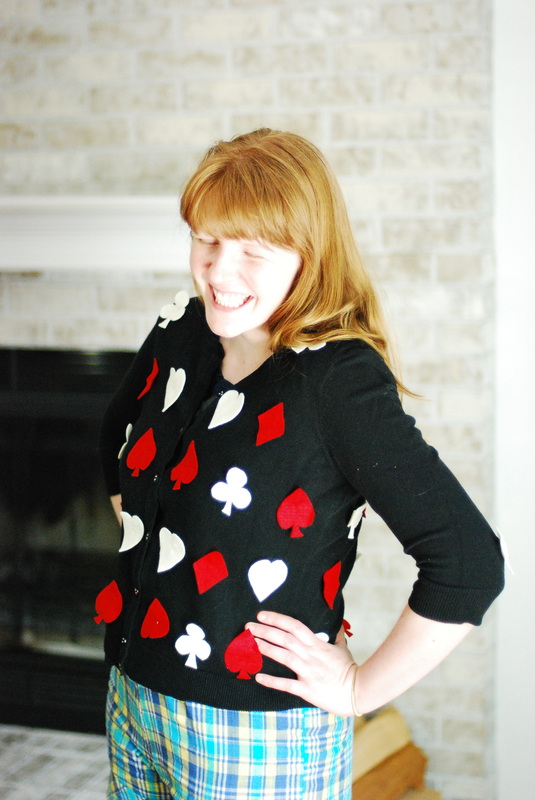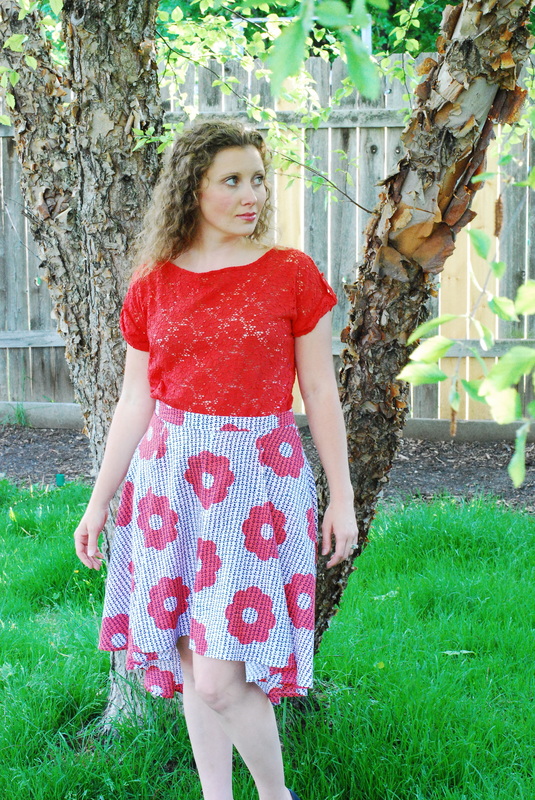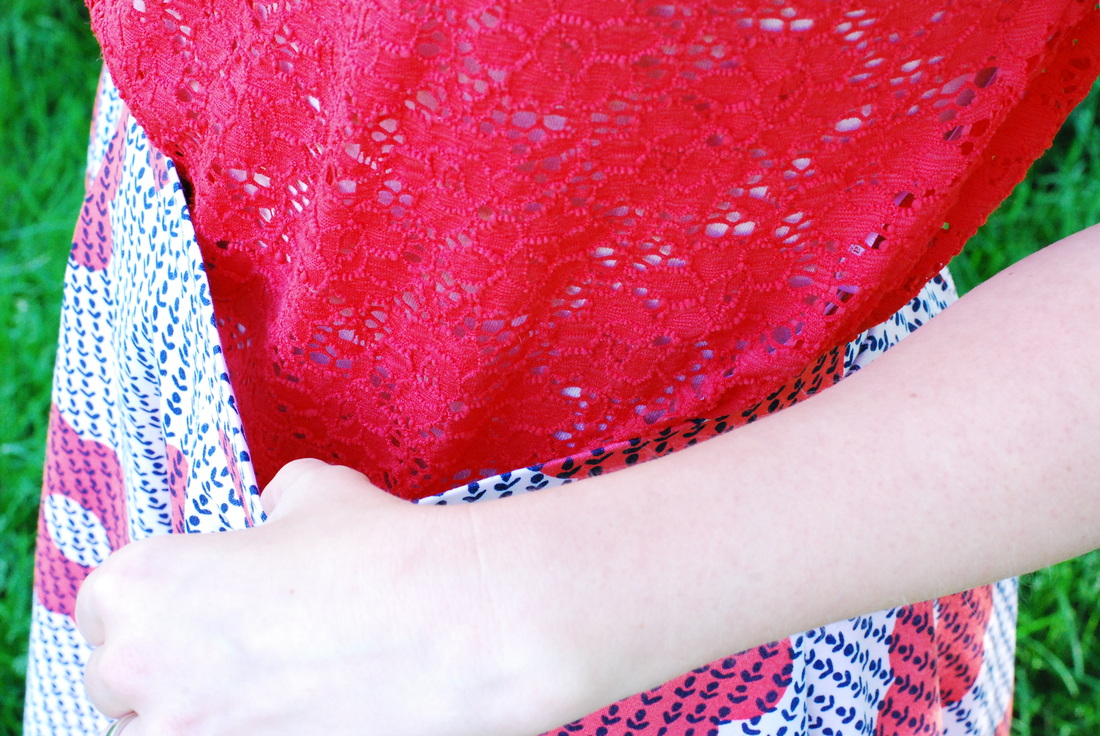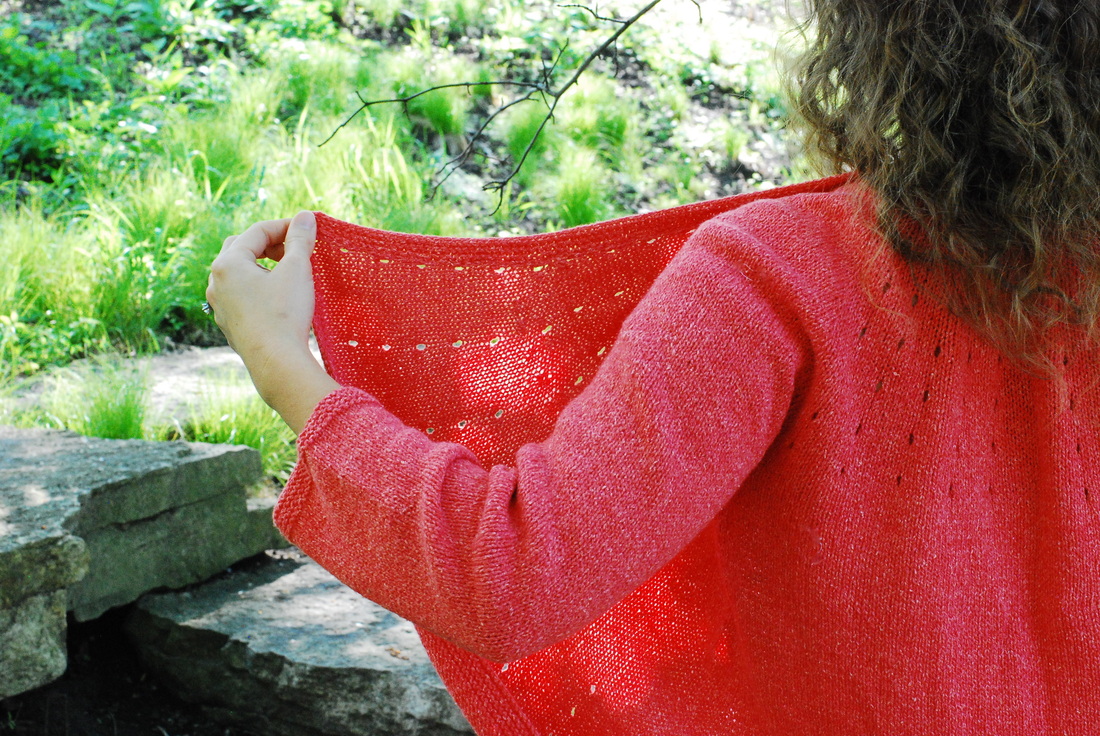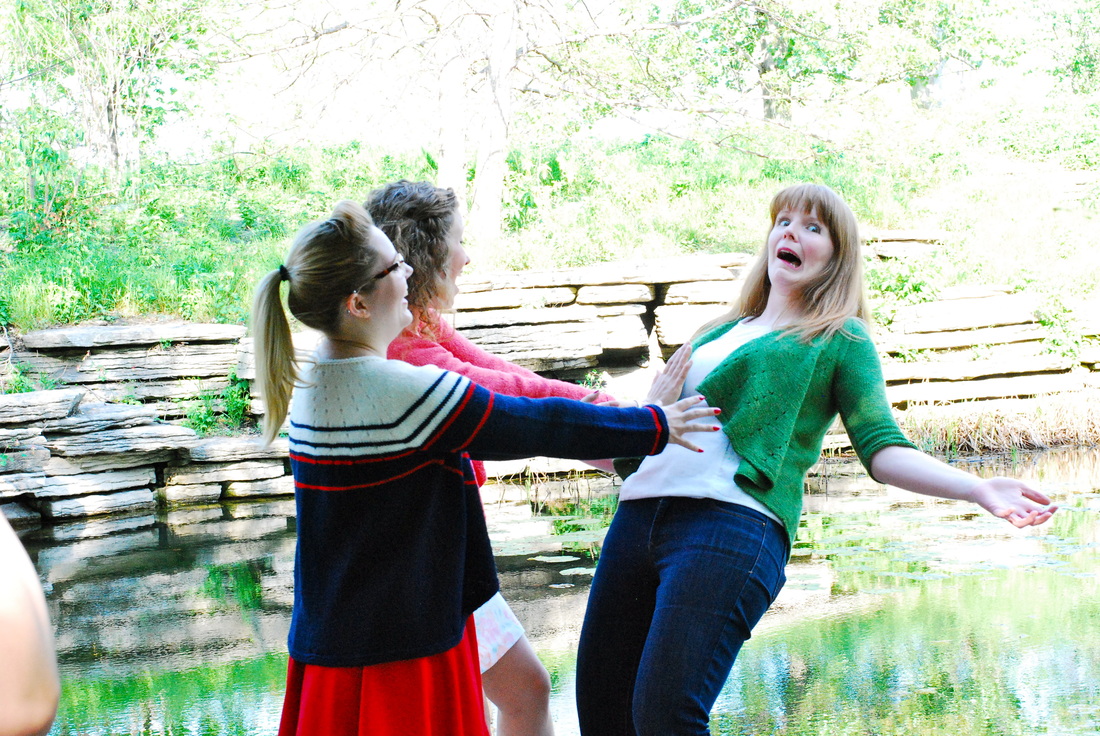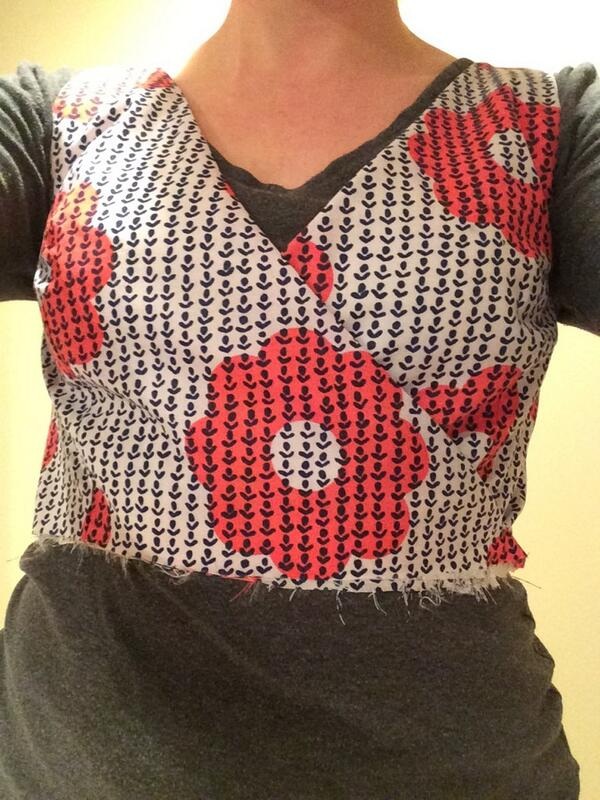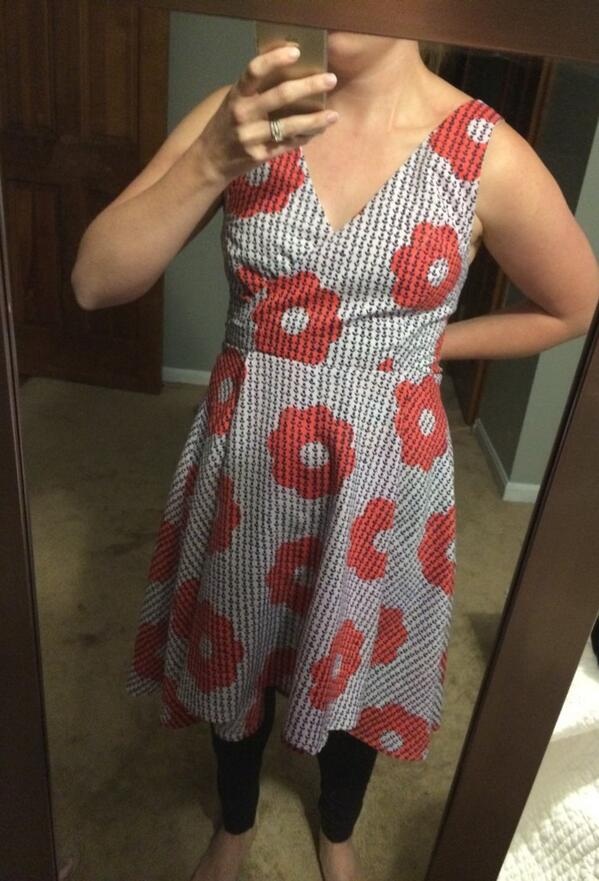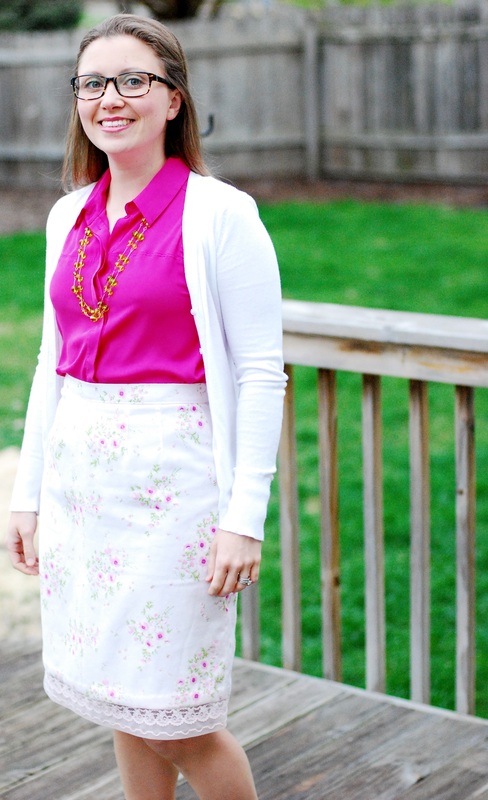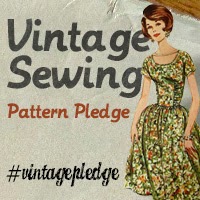|
Back in January, immediately following the the success of our Ingenue collaboration, Liz, Meg and I started knitting another sweater. Meg was on a sweater knitting roll after completing her first and second sweaters, and she had her sights set on a third. Tasha and Rochelle had recently announced their Knit for Victory KAL, and Meg easily recruited Liz and I to join her in knitting the Bridge Jumper. It was a rocky knit from the very start. We each had images of our color scheme in mind when we started searching for yarn. That's usually not a big problem considering the variety of yarns available for colorwork; however, the yarn weight recommended for this project is fingering weight- the weight a knitter would typically use for socks. For whatever reason, there are not a lot of solid color sock yarns readily available. What's worse, most sock yarns are either superwash or blends, both of which are amazing for knitting socks and really horrible for stranded colorwork knitting. Still, we pressed on. I knew that I wanted to change the original pattern. I love vintage pullovers, but felt I would get more wear from a cardigan. I also decided that I wanted a more contemporary fit than the waist length sweater directed. I swatched and recalculated stitch counts. Then, I incorporated waist shaping into the side seams. I also positioned the charts to create mirroring patterns on either side of the center line, and I prepared myself to knit my first ever STEEKED cardigan. It's been a long time since I've encountered a knitting skill that intimidated me. At this point in my knitting, I've attempted most types of garments, stitches, and techniques. However, the mere thought of taking scissors up the center of a row of knit stitches still makes me quiver. The knitting bit of this sweater went relatively smoothly and quickly (albeit boring and tedious); however, I sat paralyzed with fear once I'd cast off. I left my sweater blocking on the table for more than a week before I was able to muster the courage to cut. It's likely this sweater would still be sitting on the table as a tube if it weren't for the support and reassurance of Tasha. THANK HEAVEN FOR TASHA. When I decided I wanted to steek my sweater, I dove in head first without doing adequate research. I only left myself a buffer of four center stitches between the edges of the front piece patterns. (I know now, I should have given myself a bit more breathing room.) Terrified I was going to unravel the whole darn sweater, I sent Tasha a message. Not only did she cheer me on, but Tasha bounced ideas and approaches to steeking back and forth with me until I'd settled on the method I felt most comfortable with. Ultimately, I decided to whip stitch together the legs of two stitches on either side of my steek line. Since I intended to pick up stitches for my button band very near the edge of my steek, I wanted to feel comfortable that those stitches were securely held together. Things were still a little shaky, but I managed to pick-up and knit button bands on both edges without too much fuss. I also steeked the armholes of the sweater; those went a lot more smoothly, since I didn't have the same pattern interference to worry about. I'm not completely thrilled with my finished product. I would like to redo the shoulder join to create a wider neckline. As it is, the neckline makes it too tight to wear this sweater closed. Because of this, I skipped buttons entirely. I think there's been enough time and distance from this project that I can safely return without frustration. Liz and Meg each had their own issues with this project. Liz managed to power through. Isn't her red sweater the absolute cutest!? I think I'm telling her how much better I like her version than mine in the above photo. Liz fought with her floats throughout knitting this jumper. We strongly believe that the yarn is to blame. The yarn is a blend, not a 100% wool, and it doesn't have the same 'grip'. Liz ended up having to manually tighten and tie-off many of her floats after she'd finished knitting. In the end, it worked out. Meg on the other hand... well, she's a smart lady. Early on, Meg had a serious heart to heart with her sweater. Things weren't working out. Meg decided to decided to discard this project. I think Meg made a great choice. This sweater wasn't at all the happy fun knit she'd hoped it would be, and rather than try to bluff her way through, she knew when to fold. Meg did say that she plans to revisit this pattern someday. In the meantime, Liz had an ace up her sleeve. She surprised Meg with a bridge sweater during our photo shoot! HA! This sweater wasn't anyone's biggest success, but I think we all learned something new during the course of this project, which is a victory in itself.
9 Comments
I didn't expect my post about By Hand London's Flora dress to create the reaction it did. I want to start by thanking those who commented for sharing your opinions. I do want to note, that since the publication of my original post, BHL has posted and responded to the comment I left on their Flora bodice post. Their representatives have also responded to several of your comments directly in the comment section of my first Flora post. I think it was really wonderful to start a dialogue regarding pattern companies, testers and expectations. I'm going to wrap up everything I have to say about my experience with BHL and the Flora dress in this post. And, then I'm moving on from this particular pattern. In the comments, several people mentioned thoughts on pattern testing. I want to say that I did not, and have not ever claimed that pattern testers are paid for their endorsements. With that established, I do agree that there is an incredibly biased portrayal of patterns tested for indie sewing companies. A negative review of an indie pattern is essentially non-existent. Even if that is a conscious effort by the bloggers posting reviews to only share good experiences and stay positive, I think there should be room for sharing negative experiences and critical reviews of those same patterns. If only one side of pattern testing is revealed there is an incredibly skewed portrayal of the products being put out, and it is misleading to persons who pay and support those companies successes monetarily. When every review I read says that a pattern is wonderful, that it fits gorgeously, and that it's dreamy to sew, I buy that pattern expecting a similar experience. If every person who has bad experiences with projects chooses to put those to the side and not talk about them, it would be a disservice to the community of sewers who look to those reviews as a basis for deciding whether or not to purchase a pattern. And, I mean that to apply to both indie and big four pattern companies. Commenters suggested more transparency by pattern companies who recruit testers for their products. I think that's a great idea: How are testers selected? Does your company accept open submissions or do you cherry pick the bloggers you want to sew your garments? What criteria do you use to choose? Does your test pool represent the entire range of sizes you offer and a wide variety of body types? Do your testers have varying skill levels? What types of questions and feedback to you ask of your testers? Also, do you make changes from the test version and final pattern print? If so, are the testers sewing both versions to assure any kinks have been worked out? Etc... I think most of us expect that we will have to make some modifications to a pattern in order to achieve a good fit for our bodies. I don't think anyone expects that a pattern will fit everybody. However, a pattern ought to be designed to fit somebody directly out of the envelop. Who is that girl? Do you find someone with those proportions to test the pattern? Also, when you ask people to 'test' a pattern do you ask them to sew it straight out of the envelop to show the results of your product and design on different types of bodies exactly as it is being sold? Where is the line between testing a pattern and custom sewing a garment from a pattern? If you allow modifications during the testing phase, is it actually a test of the pattern or a demonstration of an individual's ability to modify that pattern to produce a good garment? Lots of questions. And, I'm sure others can think of more. Now, back to where this all started. My initial gripes have to do with the excess ease built into the pattern and the underarm creasing in the bodice that I tried hopelessly to eliminate.
Elisalex, a representative of BHL pattern company responded to my complaint, indicating: "The Flora wrap bodice is designed to have a more casual fit and more ease than the more fitted tank bodice variation. The gentle creasing under the bust as the top wraps is normal, and very pretty in our opinion, made all the prettier when used with a fabric with a bit of drape and body. " Here is the link to the Flora product page where the company shows two separate modeled versions of the wrap bodice dress. You can decide for yourself whether the dresses shown fit that description and explanation for the fit issues I struggled with. Suffice to say, I did have several communications with Elisalex, a member of the BHL team, all of which were courteous and promptly responded to. However, we fail to see eye to eye regarding the representation of this pattern shown on their site vs. the above stated intended fit of this garment and the resulting garment produced from the pattern. Ultimately, BHL maintains that they do not see issues with any of the above complaints. I give a lot of credit to anyone willing to pursue an independent business venture. It is certainly not an easy path to forge and it requires a lot of back breaking work. But, an independent pattern company is still a commercial entity, just like any other commercial pattern company. And, as I stated previously, as a consumer, I actually expect more from your company and product if you're a small business than if you're a mass distributor. If I was writing a negative review of a Vogue or a Simplicity pattern, most people probably wouldn't bat an eyelash. They most definitely wouldn't comment and expect me to contact Vogue or Simplicity directly before writing my criticism on my blog. It's a double standard. As I said. These are my final thoughts on this pattern and experience. It's not my aim to deter any person from exploring By Hand London's range of patterns- I haven't tried them. I do caution, however, anyone interested in the Flora pattern to know that you are not buying a well fitted faux wrap bodice dress. If that is what you're seeking, I suggest you look elsewhere. Also, keep talking. What you have to say is important. Several months ago, when Meg asked if Liz and I would be interested in knitting another sweater with her, I wasn't so sure. Not about Liz and Meg, of course, rather, the pattern she wanted to knit. The Vitamin D sweater flew under my radar. Something about the drape and the shape failed to capture my attention. Nevermind that there are 2,814 versions of this sweater posted on Ravelry, I thought. Fortunately, Meg won over my inner critic and convinced me to give it a shot, because I really enjoyed knitting this project, and I surprisingly pleased with the resulting sweater. The swing shape is cleverly created through a series of eyelet increases and short rows, which gives a knitter something to look forward to during all that stockinette. Everything about this pattern was straight forward. The only change I made was to work two extra sets of eyelet increases along the bottom edge for additional length. It is a bit tedious that ALL of the instructions are written-out, but I can't think of a shorter way to convey the steps. I think it's a necessary evil. One thing I did struggle deciding was which size to knit. The total bust measurement is different than that of a standard cardigan, due to the draped lapels. And, there weren't any suggestions regarding the amount of ease that a knitter ought to choose. I chose to use the back measurement (a) and hoped the rest would fall into place, and it seemed to. If I knit it again, I might try a size smaller to see how big the difference is. Can you tell we have fun? Because, we do. Knitting with these ladies is as much, no more, about getting together with them as it is the project! I love them so. I'm glad that Meg encouraged us to knit along with her. And, while I was initially unsure about this one, we each managed to put our stamp on our version. It's really entertaining that the three of us started out from the same pattern and ended up with three unique and distinct sweaters. Just look at Liz's striped Vit D! I'm kind of in love with it. I might also copy her so I can have a striped Vit D. It's a good thing Liz is good at math, because she had to make a list of modifications to tailor her sweater to her petite form. The result is brilliant! Liz somehow even manages to give this very contemporary style a vintage vibe that stays true to her everyday aesthetic. Pretty impressive! Meg, accidentally knit her Vit D in fingering weight! She usually has to knit things longer than Liz and I, anyway, so changing gauge was an undertaking! But, she came out on top! And, that drape! Meg's sweater is knit in alpaca, and it drapes GORGEOUSLY. GORGEOUSLY. I knit my sweater with spring in mind. It's knit with Silky Wool, and I really love the weight of the fabric, even if it doesn't drape like Megs. :-D In a lucky stroke of coincidence, it compliments one of my new straight skirts perfectly! DOUBLE BUBBLE project post! It reminds me of a juicy slice of watermelon! Alas, I would be remiss if I failed to credit our wonderful, talented, and very attractive photographers Mike and Felix! These guys. They're the absolute best. Really, the three of us are all "SQUEE" and "AHH" and "GIGGLE" when we get together and, these men roll with the crazy and make us look gorgeous in the process!
I try to keep my online presence positive. It takes a lot of courage to throw yourself out into the internet, and I think the crafting community is particularly respectful and mindful when it comes to sharing and commenting. That said, there is also space for constructive criticism. Everything boils down to a matter of opinion, and we don't all have to agree all of the time. What I'm about to say is difficult for me, because I really wanted to like this pattern and the independent pattern company who publishes it. I asked Twitter for help, and made the following modifications:
Note the odd boob wrinkle and the, still, excess fabric in the bodice. By this point, I hoped that the skirt and the earth's gravitational pull might help to resolve some of the issues, and it did, a little. But it still doesn't FIT. Convinced of some personal ineptitude, I started searching for other versions of the wrapped Flora. I had expected to learn that I was a complete moron; instead, I noted that NONE of the Flora's produced by sewers, much more capable than me, might I add, FIT. Every version I was able to track down had some combination of blousey and boob wrinkles. And, when the ladies of BHL used the wrap bodice to demonstrate how it might be used to sew a blouse, there was absolutely no question that this poor fit is the result of bad drafting. Oddly, a large percentage of people who have sewn this dress, do not have any complaints with the results of this pattern. Some of the bloggers who have sewn the wrap version of Flora do note issues with the fit. Most who take issue with the fit of this bodice, place the blame on themselves. I disagree. I think that the pattern produces very consistent results. And, the problem with the fit of the dress is in the drafting of the pattern pieces, and not with the body type or sewing of the maker. Ultimately, I feel this pattern was a waste of time and money, especially considering I could buy a high-low skirt pattern for $3.99 during a ClubBMV sale vs. the $34.02 (US) it cost me to buy and ship a pattern from BHL. Now, pissiness and griping aside, there are some things about this pattern I did like. First the packaging and instructions are top notch. I REALLY like the method described for self-facing the bodice. It beats having to hand-stitch shoulder seams closed, any day! Also, the skirt is really lovely. I'm a huge fan of box pleats, and the high-low option is a really fun and interesting design feature. This is skirt 3 of 5 straight skirts I made myself in April. I'm a bit behind on documenting them. I cut this skirt using the same modifications I made on my first, leopard version. But, for the sake of keeping things interesting, I added a lace trim to the hemline. My fabric looks washed out against my fluorescent blouse. It's not white, rather, pale, blush pink. Which is a step for me. I went through a pink phase towards the end of high school, and I haven't worn it since. It might be time to bring it back. At least, I'm trying it on. I did feel very light and springy walking around in pink and florals yesterday. Most everyone I encountered was still dressing in grey and black. Spring hasn't quite sprung here; however, our grass is turning green, which makes me confident we're close! The addition of the lace to the hemline takes this skirt length to the border line of suitable skirt lengths, IMO. I should have factored in the additional length and shortened things by an inch overall to keep the hem just above the kneecap. Next time. To attach the lace, I placed the lace on the skirt, right sides together. I stitched a straight line of stitching through the top edge, and then pressed my hem allowance up and away. Then, I secured the hem by hand. This skirt is my least favorite of the bunch due to the wrinkle factor of the fabric I used to see with. Otherwise, it's perfectly wearable and a nice addition to my closet. |
Archives
March 2017
|
